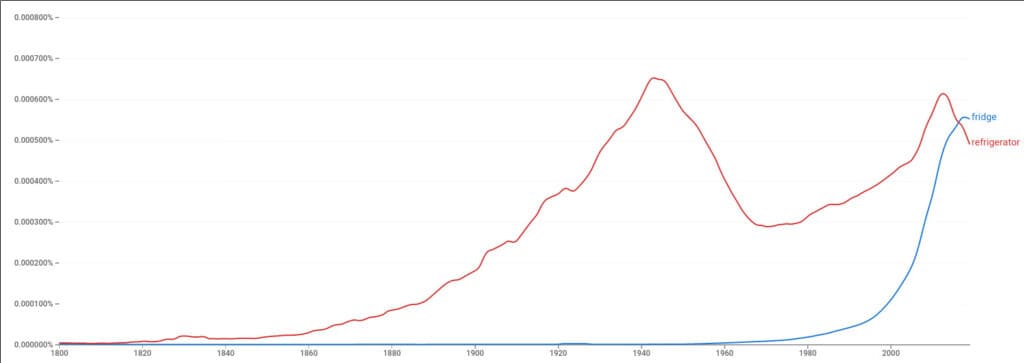In English, there’s no shortage of oddities and weirdness. One of the biggest sticking points for both second language learners and native English speakers alike is spelling. English is a language of borrowed words. Over 75% of all English words are loanwords! (If you’re interested in learning more about this, check out my article on how much of the English language is actually English)
When English borrows a new word from another language, it likes to keep the spelling the same. This leads to words that are pronounced differently than they’re spelt and an overall mess for everyone when it comes to spelling.
“Refrigerator” was borrowed into English from Latin and keeps the Latin spelling while “fridge” is a word derived from refrigerator by English speakers. At first it was spelt “frig”, but as time went on it merged with regular spelling rules to become “fridge”; similar to words like “bridge” or “ledge”.
The Journey from Latin
The word “refrigerate” comes to us from Latin where the word is refrigerare. This is spelt in almost exactly the same way as the English refrigerator and refrigerate except the Latin verb ending -re is remove and English word endings -ate and -tor are added to the words.
Ultimately, refrigerare in Latin is derived through the Latin adjective frigus, which means cold, this is also where we get the word frigid from in English.
These words, refrigerate and refrigerator, have been in English since at least the 1600s. However, they were mostly relegated to a scientific usage as most Latin derived words are. This all changed when the appliance we now call a fridge was invented.
The concept of artificial refrigeration was developed in 1748 by a Scottish chemist named William Cullen. Nearly a century later in around the mid-1800s, the first examples of early refrigerators were being built. It was around this time that the word “refrigerator” began to be used in a much wider context among many more speakers of English.

The graph above shows the occurrences of the words “refrigerator” and “fridge” in print between the years 1800 and 2019 courtesy of Google’s ngrams viewer.
We can see that around the year 1830 the word “refrigerator” starts to appear in print much more often than in years previously. In 1860, the word begins to pick up steam and reaches its peak usage in 1943.
Conversely if you look very closely, you can see a small uptick in the word “fridge” appearing in print in 1920, but the word really starts to see wide adoption in the 1960s.
Keep in mind that the graph above is only a relatively narrow selection of language use. It only describes the language in books digitized by Google and has no information about English as it was spoken in those time periods.
We can imagine that the shortened word “frig” and the modern “fridge” were used much more often when speaking than they were when writing until only fairly recently.
Let’s Shorten That a Little
If there’s one thing you can count on when it comes to language, it’s that people are lazy. Words will be clipped and shortened whenever possible to simplify the exchange of information. The word “refrigerator” is no different.
While the refrigerator was still new, the entire word was usually used to refer to the appliance that keeps our food cold. However, as early as 1920 we start to see the clipped word “frig” being used to refer to the refrigerator.
As we saw above, as fridges became more prevalent in people’s homes (around 1960) the word fridge began to see widespread use among an increasing number of people.
So why the “D”?
So if we get the word “fridge” from the word “refrigerator”, where does that D come from?
As we saw above, when people first started to clip refrigerator into a smaller word they used the word “frig”. This makes sense because, as we know, there is no D in refrigerator.
However, this spelling of the word leads to some confusion because English pronunciation rules would lead us to believe that this new word would be pronounced with a hard G sound (/g/) at the end of it (/frɪg/).
In fact, there is already a verb to frig in English with multiple meanings such as “to rub” or more vulgar meanings similar to the English swear word “fuck” and as expected this word is pronounced with a hard G sound similar to other words ending in G: pig, plug, rug, beg, etc.
Unlike the verb to frig, the clipped form of refrigerator was pronounced with a /dʒ/ sound instead. It’s likely that as the popularity of refrigerators as appliances grew and the word began to be used in print more often, English speakers decided to bring the spelling of the word in line with other words with the /dʒ/ sound.
This meant adding a D to the word to regularize it and make it similar to other words with /dʒ/: bridge, ledge, dodge, etc.
Conclusion
Ultimately, this left us with the word we all know and love today “fridge”.
It’s a very common occurrence in English for words that are borrowed from other languages to retain their spellings even if this means that they might break the pronunciation rules of English.
However, the word “fridge” was an entirely English coinage. It was created by English speakers and so English speakers molded it to fit to the pronunciation standards we expect to see.
That was another article from my Hidden History of English series. If you liked it, you will probably enjoy my other articles in the series. You can check them out here. I hope you learned something new and interesting about the English language today. I’ll catch you in the next article!



